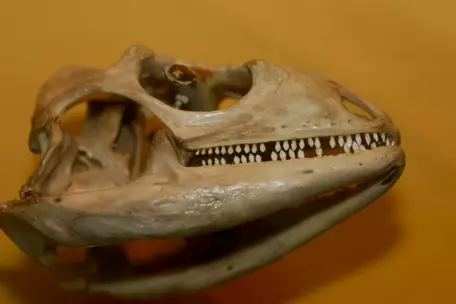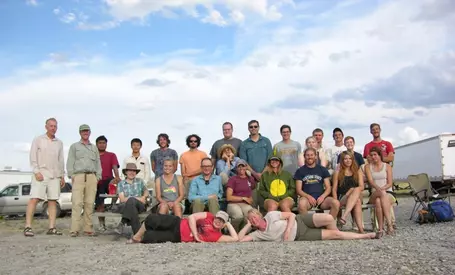Paleontology - Egg Mountain
Author: Willie Freimuth, Dept. of Earth Sciences, Montana State University
In the spring of 1978, Marion Brandvold and her family, owners of a small rock shop in Bynum, MT, discovered some small grey fossil bones west of Choteau. That summer, former Museum of the Rockies paleontologist Jack Horner (then working as a preparator at Princeton) and Rudyard High School teacher Bob Makela identified the bones as belonging to a baby duck-billed dinosaur. Brandvold led them to where she had discovered the bones, which would come to be the first dinosaur nest that contained hatchling baby dinosaurs. The following year, Horner and Makela returned with a crew and discovered several other dinosaur nests in the same area.
In July of 1979, volunteer crew member Fran Tannenbaum was prospecting for fossils along a seismic line laid out by an oil company. She came to the top of a small hill and discovered the large pieces of fossil eggshell that were part of the first dinosaur egg ever found in North America. The oil company agreed to divert their drilling operations in that area so the crew could excavate. This is the site that came to be known as Egg Mountain. Over the next few years, their subsequent discoveries and work at Egg Mountain and the surrounding area paved the way for the next 40 years of research on dinosaur paleobiology, reproduction, and social behavior. Oh, and the name of the oil company? Shell.
This page will take you 75 million years into the past during the Cretaceous period and provide an overview of the dinosaurs and other creatures, their behavior and life history, and their environment. Then, we'll tell you how geologists and paleontologists make inferences about dinosaur behavior from fossils and geologic evidence. Finally, we'll tell you where you can learn more about these organisms and get involved with paleontology in Montana.
Paleoenvironment

During the Cretaceous period, a shallow tropical inland sea, the Western Interior Seaway, split North America in two. Real estate in Montana during this time would have been very expensive -- much of the state sat on the coastline of this tropical sea. Over millions of years, the seaway underwent several transgressions and regressions, or relative rises and falls of sea level, respectively. A portion of the rise and fall of the Interior Seaway is recorded in the sedimentary succession near Choteau, MT.
Egg Mountain is a locality in the Two Medicine Formation, a 600 meter thick package of rocks that were deposited in western Montana from around 83 to 75 million years ago in the Campanian epoch of the Late Cretaceous period. This is about 8 million years before T. rex and Triceratops roamed Montana, and about 10 million years before the extinction event that wiped out all non-avian "Avian" refers to birds. And yes, birds are modern dinosaurs! Birds lived alongside dinosaurs and survived the extinction event at the end of the Cretaceous. There is ubiquitous paleontological evidence that suggests a group of dinosaurs, called theropods, are the descendants of modern birds. Next time you eat chicken or turkey, remember that you are eating a dinosaur! dinosaurs. Within the Two Medicine Formation, Egg Mountain and the other dinosaur-bearing rock layers are found in the Willow Creek Anticline. An anticline is a structural geology term used to describe a hill where the layers of rock form an upside down U shape. This happens in commonly in mountain building, like the Rocky Mountains, where compressional forces fold and bend rock layers, similar to pushing on the edge of a rug. After millions of years, some of the top layers in the Willow Creek anticline have eroded away, leaving exposed the layers that contain Egg Mountain, dinosaur nests, and an extensive dinosaur bone bed.
The sedimentary rocks at Egg Mountain were deposited at height of a regression, when the coastline of the sea was as far east as Billings, MT. Carbonate-rich sediments shed off the newly uplifting Rocky Mountains were deposited in systems of braided streams and small lakes. This environment was much closer to the mountains than to the seaway 200 miles away. The uplifting Rockies also produced volcanism, recorded in igneous rocks in the Elkhorn and Adel Mountains southwest of Choteau. Layers of volcanic ash, called bentonite, are evidence of volcanic activity and are common features used to obtain radiometric dates.

Generally, the climate of the area during this time is thought to be predominantly semi arid and dry with seasonal changes in temperature and precipitation. The climate of modern day East Africa is a helpful analogy. Geologists use several lines of evidence to support these interpretations. Abundant hard nodular rocks are present in the sediments surrounding Egg Mountain. These are caliche ("cah-leech-ee") nodules, which form in soils in semi arid environments today, such as the southwestern United States. Fossil conifer tree stumps preserve interrupted growth rings, as do tree species during times of drought in East Africa today. Large amounts of herbivorous dinosaur bones of the same species that include both young and adult specimens suggest that those animals may have perished in drought-like conditions. Finally, study of oxygen isotopes from sedimentary rock deposited along the coastal plain during this time provide evidence for a monsoon season with annual rainfall.

A Mountain and an Island in the Sun: the paleoenvironment of Egg Mountain
Egg Mountain "proper" is specific to the site on the small hill where Fran Tannenbaum discovered the first dinosaur eggs, though the surrounding area is often referred to as Egg Mountain as a whole. A nearby site with eggs was found in 1983, called Egg Island. Between these two localities, several nests were excavated, and the area has been interpreted as a dinosaur nesting ground. The Egg Mountain locality itself displays few geologic clues as to what the local environment was like. Horner hypothesized that Egg Mountain and Egg Island may have been a dinosaur nesting ground that was part of a seasonal island or peninsula, bordered by an alkaline lake. Lenses of hard carbonate rock at the localities may have been formed in a lake environment, but their origin has been debated. Nearly all of the fossils discovered at Egg Mountain are terrestrial -- they are all animals that lived strictly on land. In addition, many are found in situ, meaning they were discovered in their original position. Examples include dinosaur nesting structures, eggs and egg clutches, and abundant fossil insect cocoons and pupation structures. Their role in the interpretation of the environment at Egg Mountain will be addressed in the following sections.
Egg Mountain: The Cast
Maiasaura peeblesorum

![[creative commons]](/images/creativecommons_16.png)

In a state famous for Tyrannosaurus rex and Triceratops, it is no small feat that Maiasaura is the Montana state fossil. Maiasaura, the generic name, means "good mother lizard" and the specific name is an homage to the Peebles family, on whose land the first Maiasaura remains were unearthed. The discovery of embryonic and hatchling remains were discovered in a bowl-shaped nest, and analysis of their bone structure suggests that the young were unable to walk. Additionally, wear patterns on the hatchling teeth suggest they had been feeding before their untimely demise. This combination led Jack Horner and Bob Makela to surmise that the nestlings were being fed, presumably by the mother Maiasaura. For a more detailed account of dinosaur social behavior, see below.
At Egg Mountain, Maiasaura are represented by shed teeth, eggshell and eggs, and bones. In the Willow Creek Anticline, there are footprints and coprolites of Maiasaura, as well as an enormous bone bed with abundant skeletal remains.
Troodon formosus
Troodon, whose name means "wounding tooth," is a person-sized carnivorous dinosaur and one of the closest relatives to modern birds. In one of the most significant revisions of original hypotheses about Egg Mountain, several egg clutches originally attributed to Orodromeus were reassigned to Troodon based on analysis of embryonic remains in the eggs. This has led to significant discussion linking dinosaurian and avian (bird) reproductive physiology and behavior, research spearheaded by MSU paleontologist Dr. David Varricchio (see more below). Troodon teeth can also be found at Egg Mountain.
Orodromeus makelai

Named after the late Bob Makela, co-author with Jack Horner on the first Maiasaura nest with hatchlings, Orodromeus is a labrador-sized herbivorous dinosaur. The first eggs from Egg Mountain were thought to belong to Orodromeus, but have since been reassigned to Troodon. The closest relative of Orodromeus is another small dinosaur called Oryctodromeus, who is found in southwestern Montana and attributed as the first burrowing dinosaur. Orodromeus bones are found at Egg Mountain.
Daspletosaurus horneri
A relative of the famous T. rex, Daspletosaurs horneri is a recently described tyrannosaur from the Two Medicine Formation. Its skull is on display at the Museum of the Rockies (pictured below). The only evidence of tyrannosaurs at Egg Mountain are shed teeth.
Mammals at Egg Mountain

Aside from dinosaur nesting remains, Egg Mountain has produced some of the best fossil mammals from the Cretaceous of North America. Two species are known -- Alphadon halleyi, a relative of modern marsupials, and Cimexomys judithae, a member of an extinct group of mammals called multituberculates. In many cases, the only mammal remains from this time period are teeth. At Egg Mountain, skulls and associated skeletal remains are found, making the site important for studying these animals.
Lizards at Egg Mountain
Alongside the abundant and exquisitely preserved mammals are the remains of lizards. Magnuviator ovimonsensis, which translates to "mighty traveler from Egg Mountain," is a relative of modern iguanas. Morphological analysis of its teeth suggest it may have fed on the abundant wasps and other insects at Egg Mountain. Other varanid lizards are preserved, part of the group that includes modern day monitors and Komodo dragons.

Dinosaur Paleobiology: growth, reproduction, and social behavior
Marion Brandvold's discovery of the first dinosaur hatchlings and Fran Tannenbaum's dinosaur egg are spectacular in their own rights, as are the several other discoveries at Egg Mountain and the surrounding area. But what can scientists tell about dinosaur behavior and life history based on these discoveries? How do these behaviors compare to dinosaurs closest living relatives, birds and crocodylians? We will look at two case studies -- Maiasaura and Troodon.
For all scientists, it is important to separate observations, which are unbiased reports of things you see, hear, or notice, from interpretations, which explain the meaning of those observations. For example, an observation would be that a Maiasaura bone is small and has a spongy texture. Based on those observations, you may interpret that bone as belonging to a juvenile Maiasaura. Observations and interpretations about dinosaur social behavior will be separated here.
The Good Mother Lizard
In 1978, Marion Brandvold led Jack Horner and Bob Makela to the site where she found the remains of a baby Maiasaura. Fifteen other baby dinosaurs were discovered at the same site, all preserved in a depression that looked like a giant salad bowl. All the bones showed signs of immaturity -- parts of the backbone and limb bones were unfused, and the ends of the limb bones were spongy. Similar bones are found in newborn animals that are unable to walk. Interestingly, jaw bones with teeth found at the site showed signs of wear -- the babies had been eating, even though they could hardly stand on their own. All the bones were of the same dinosaur, Maiasaura, and all were found in this bowl-like depression. Based on all this evidence, Horner and Makela determined they had found the nest of a Maiasaura, whose babies had to be taken care of and fed while in the nest. This was the first ever evidence for parental care in dinosaurs.
But does this make sense? We can compare this inferred parental care in dinosaurs to their closest living relatives, birds In fact, birds are living, flying dinosaurs! Birds are a living group of theropod dinosaurs, a group that includes T. rex and Velociraptor. Next time you're eating chicken or turkey, remember that you're eating a modern dinosaur! and crocodiles. Crocodiles and alligators and some birds, like robins, care for their young upon hatching. It is not unreasonable to think that dinosaurs may have done the same.
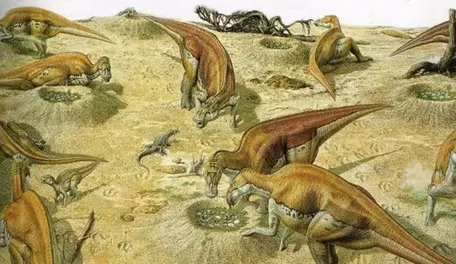
From 1978 to 1983, Horner and company found 13 more nests with 31 babies. Eight of these nests were found along a single horizon, or a single layer of rock in the Willow Creek Anticline. On average, these nests were spaced 23 feet apart. Curiously, the average length of an adult Maiasaura is around 23 feet. Because of the spacing of nests on a single horizon, it is thought that horizon represents a nesting ground, where Maiasaura would gather and lay eggs in colonies. Many species of birds, like gannets in the video below, nest in colonies to protect their young from predators. There's safety in numbers!
Other Maiasaura nests are found at different levels in the Willow Creek Anticline. This suggests Maiasaura may have returned to the same nesting grounds year after year and generation after generation, an act described by the term site fidelity. There are several examples of modern birds returning to the same nesting site over generations.
Nesting behavior is not the only interpretation scientists have made about Maiasaura social behavior. An extensive bone bed, or a single horizon with thousands of bones, was pieced together after several individual sites containing Maiasaura bones were discovered. This bone bed contains the remains of thousands of individuals, all attributed to individual Maiasaura that died at roughly the same time. Bones from dinosaurs in every stage of life are present, from juveniles through adults. Based on the mass grave, it is interpreted that Maiasaura lived in expansive groups or herds. Just like nesting in colonies, herds provide protection from predators. Large mammalian herbivores live in herds today, like bison, zebras, and wildebeest.
The abundance of Maiasaura bones of a variety of ages gives scientists an unprecedented look at ontogeny, or the growth stages through the life of these dinosaurs. By studying the histology of many bones, where researchers cut open bones and look at the microscopic structure, we have a good understanding of how Maiasaura grew. In fact, they grew very rapidly. A study led by Oklahoma State professor and Montana State doctoral graduate Holly Woodward Ballard found that Maiasaura were just over one foot long as hatchlings but would have grown up to nine feet after just one year. Mature adults would have reached a length of 30 feet in about eight years. The rapid growth seen in Maiasaura approaches rates seen in birds and other large-bodied warm-blooded mammals, like elk. This adds to an ever-growing line of evidence that suggests dinosaurs were active, warm-blooded creatures, more like birds and mammals and less like reptiles.


Here's a summary of several observations and corresponding interpretations made from studies on Maiasaura nesting and bones:
Observation: Several tiny bones from many individual Maiasaura were found in a bowl-like depression. The bones are unfused and spongy-looking, but there are teeth that show wear.
Observation: Several nests in a single layer of rock are evenly spaced nearby one another.
Observation: Maiasaura nests are found at different levels in the same area of the Willow Creek Anticline.
Observation: Abundant bones from many individuals represent juveniles, teenagers, subadult, and adult Maiasaura and are all found in the same layer of rock in the Willow Creek Anticline.
A Difference in Parenting: a look at Troodon nesting

The fossils of the Willow Creek Anticline provide one of the best pictures of dinosaur life, from beginning to end, for Maiasaura. But the rocks tell another story of dinosaur life and reproduction. From 1979, when Princeton undergraduate Fran Tannenbaum discovered an egg on top of Egg Mountain, until 1983, several dozens of eggs in several egg clutches were found at Egg Mountain, with embryonic bones inside some of the eggs. In the same area, abundant bones of the small herbivorous dinosaur Orodromeus were found. Because they were from the same area, the eggs were deemed as those of Orodromeus, and the arrangement of nests and bones suggested they were part of a nesting ground. Nests were also found at different levels in the section, which suggests site fidelity, where Orodromeus would have returned year after year to breed in the same area.
However, when the embryonic bones were fully prepared in the laboratory, a completely different story unfolded. These were the bones of Troodon, not Orodromeus. This change in identification has important implications not only for the paleoenvironmental context of Egg Mountain, but for the evolution of traits between dinosaurs and birds. Troodon is a member of the group of dinosaurs that is most closely related to modern birds. These dinosaurs, called theropods, shared many skeletal features with birds, including hollow bones, flexible wrists, and a wishbone. Many dinosaurs in this group had feathers. They also share a number of reproductive traits, which are addressed below.
Similarities with Birds
Troodon reproduction and life history has been the focus of Dr. David Varricchio's research at Montana State University. Through his work and others, several reproductive traits can be seen in both Troodon and modern birds. First, the eggshell of Troodon eggs is smooth, like bird eggs, and have a similar layered microstructure. The eggs themselves are also bird-like, elongate, and asymmetrical -- they are wider at the top and pointed at the bottom, compared to Maiasaura eggs which are round. One egg clutch was found encircled by a rimmed nesting structure with no evidence of plant cover. This led Varricchio and others to believe the eggs were laid in an open nest. They suggested Troodon may have brooded their nest like many modern birds do. A different Troodon specimen from northern Montana preserves a partial skeleton on top of some eggs, which may be remnants of a brooding parent. This same specimen sits on top of a very large clutch with many eggs, and the bone microstructure of the brooding adult does not match the structure seen in modern brooding female birds. This suggests that paternal care -- fatherly care -- was employed by Troodon, a behavior that is seen in some modern birds with large egg clutch sizes.
Troodon hatchlings show differences from Maiasaura hatchlings. Troodon embryos -- young found inside unhatched eggs -- had more developed bones, unlike Maiasaura young. This suggests Troodon hatchlings were able to walk around and fend for themselves to some degree, as opposed to Maiasaura young that may have required some degree of parental care. Both of these behaviors are seen in modern birds and crocodylians.
Differences with Birds and Crocodylians
However, there are other Troodon reproductive traits that differ from modern birds and crocodylians. The arrangement of Troodon eggs within a clutch is rather curious. They are arranged in pairs, similar to other theropod dinosaurs. However, modern crocodylians do not order their eggs. Modern birds sequence their eggs individually, which reflects their internal anatomy -- they only have one functioning oviduct, which is the tube that carries the egg from the ovary to the cloaca, where the egg exits the mother when laid. One oviduct is thought to be adaptation to reduce the weight of the bird, which is helpful for flying. Based on the Troodon egg arrangement, it appears Troodon had two functioning oviducts, a more primitive condition compared to birds. The way Troodon eggs are placed in the sediment is also different from modern birds and crocodylians. Alligators and crocodiles completely bury their eggs, while bird eggs rest on top of the soil in an open nest. While Troodon nests are believed to be laid openly as well, there is a sediment change about 2/3 of the way from the bottom of the egg. The sediment around the bottom of the egg is the same as the sediment in the rest of the rimmed nesting structure, but the sediment around the top of the eggs is different. Additionally, the bottom of the eggs are more porous, or have many small openings that allow the young to breathe. Modern crocodile eggs, which are completely buried, have high porosity. The tops of Troodon eggs are less porous, which matches modern bird eggs that are laid in open nests. All of this suggests Troodon partially buried its eggs, a behavior that is not seen modern crocs or birds, but is thought to exist in other dinosaurs.
Here is a summary of several observations and corresponding interpretations made from studies on Troodon nesting and bones:
Observation: Eggs are elongate and asymmetrical with smooth eggshell that has three distinct layers. Modern birds have smooth, asymmetrical, and three-layered eggs.
Observation: Eggs are arranged in a compact circle at the center of a rimmed nesting structure. There is no apparent plant cover in the nest. Additionally, a partial adult Troodon was found on top of some eggs.
Observation: Within the nest, eggs are arranged in pairs. This is unlike modern crocodylians, which lay their eggs in mass, and modern birds, which lay their eggs sequentially. This paired arrangement is documented in other theropod dinosaurs as well.
Observation: The sediment composition around the eggs changes about 2/3 from the bottom of the egg. Additionally, there are few pores (small holes) on the top of the egg relative to the bottom of the egg.
Observation: Troodon embryonic bone is more dense and developed than Maiasaura embryonic bone.
Observation: Troodon lay a high number of eggs and brooding Troodon parents do not have similar bone structure as modern female brooding birds. It is common for modern male birds to care for clutches with a high number of eggs.
Invertebrates and Trace Fossils: the Under-Studied Understudies
In most cases, when someone mentions a fossil, you probably envision a body fossil. Body fossils, as the name implies, are fossilized remains of an organism's body. The most common examples are bone, teeth, shells, and exoskeleton remains -- these are referred to as the "hard parts" of an organism. In rare instances, soft tissues of an organism are preserved. This structures includes hair, feathers, skin impressions, or internal organs.
Trace fossils are a record of an organism interacting with a medium, or substrate. Trace fossils include structures like burrows, trails, footprints or tracks, nests, borings, and coprolites (or fossilized dung). Ichnology is the study of trace fossils. Trace fossils tell scientists many things that body fossils cannot. They are a direct record of organism behavior in response to an environmental stimulus. In a sense, trace fossils are a link between biological processes and geological processes. Trace fossils at Egg Mountain and the surrounding area include dinosaur nesting structures, dinosaur tracks, coprolites, invertebrate burrows, insect pupation chambers and cocoons, and root traces.
Dino dung and a Cretaceous food web
Sure, one can look at the shape of a tooth and other skeletal features to figure out what dinosaurs may have eaten, but how do we know exactly what they ate, and what does that mean for the environment in which they lived? You look at their poop, of course. That's exactly what University of Colorado-Boulder researcher Dr. Karen Chin did with coprolites, or fossilized poo, from the Willow Creek Anticline. She described several coprolites produced by large herbivorous dinosaurs, likely Maiasaura. In the fossil "dino pies" were the remains of conifer plants (like spruce and pine trees), which seems to be the preferred option Grasslands, like those in eastern Montana today, had not evolved yet. Conifers and flowering plants were the dominant groups and the main source of food for herbivorous dinosaurs. on the menu for Maiasaura. Chin also observed that there were burrows in the coprolite, likely made by the relatives of modern day dung beetles. This trio of dinosaurs, dung beetles, and conifers gives a unique look at the ecosystem of the Rocky Mountain Front during the late Cretaceous.
Pupation Paradise: what insect trace fossils tell us about dinosaur nests
In some cases, trace fossils are useful tools for interpreting past environments and depositional processes in the absence of any informative geological data. The abundance of trace fossils at Egg Mountain allows for just that. Thousands of small ovoid structures have been unearthed, some of which have a helical weave or ribbed pattern. Horner first described the trace fossils as the cocoons of carrion beetles, which may have scavenged the dinosaur nests in the area. However, similar structures have since been discovered in surrounding strata and re-interpreted as the cocoons of burrowing sand wasps (though other insects cannot be definitively ruled out).
Based on the above interpretation, modern sand wasps may be a good analog for the fossil cocoon-makers at Egg Mountain. Modern sand wasps have relatively confined environmental preferences -- most live in habitats with soils that permit burrowing and with little vegetation cover in semi arid and dry climates. They also prefer burrow and lay their eggs above the groundwater table in well-drained soils. These parameters jive with interpretations by other studies of the Two Medicine Formation paleoenvironment. If this is the case, there are important implications for the paleoenvironment of the Egg Mountain locality and its organisms. Similar conditions favored by burrowing wasps may be favorable for other small vertebrates who may have burrowed, like mammals and lizards. Theses conditions also may be preferential for creatures that construct nests, especially an animal like Troodon which partially buries its eggs in the soil. All these organisms would benefit from soil that is easy to mold and rework to their liking, and soil that is well-drained so their homes, burrows, and nests do not become waterlogged.


Paleontology in Action: Field work
Most of the time, dinosaur digs involve a fair amount of prospecting, or scouring the landscape looking for large fossil bones poking out of the ground, and then excavating and jacketing those bones to be brought back to the laboratory and prepared for research and/or display. Field work at Egg Mountain is a bit different. In the early 1980's Horner and his crew opened up a quarry on top of Egg Mountain, where they would remove layer after layer of rock and collect fossils as they went. Most of the discoveries -- eggshell, teeth, baby bones -- are very tiny. The same technique has been carried over by Dr. David Varricchio of Montana State University. From 2010-2016, Varricchio and a field crew opened a quarry at Egg Mountain adjacent to Horner's. They worked to "peel back" layers of rock, often using a jack hammer to break through the tougher carbonate rocks. Crew members would "work the line," sweeping up the rubble and sorting through it in search of any fossil material.
For as much notoriety and credit researchers get for new fossil discoveries, volunteers and amateurs are a huge part of paleontology discoveries and studies. All across Montana and the western US, field expeditions led by universities and museums seek eager volunteers to assist with field work (for interested parties, see the Montana Dinosaur Trail).

![[creative commons]](/images/creativecommons_16.png)


Explore Montana's Paleontology for yourself:
Montana Dinosaur Trail
Explore the Montana Dinosaur Trail, a road map that highlights Montana's rich history of dinosaur paleontology. Follow the route to museums across the state and read about their associated programs and field opportunities.
Highlights:
- Museum of the Rockies - Part of the Montana State University campus at Bozeman and a Smithsonian Affiliate, MOR boasts an extensive collection of dinosaur fossils and exhibit halls. Come for the dinosaurs, but stay to see the permanent regional history exhibits, the Taylor Planetarium, the outdoor Living History Farm, and a number of traveling exhibits. Get DIRECTIONS.
- Old Trail Museum - Situated among a block of quaint buildings teaming with western history on the north side of Choteau, the Old Trail Museum provides an excellent overview of dinosaurs and paleontology along the Rocky Mountain Front. You can't miss the brightly colored Einiosaurus and T. rex in the parking lot, then wander inside and see a mother Maiasaura and her nest among other wonderful fossils on display. Afterwards, head next door to the Ice Cream Parlor for a waffle cone! Get DIRECTIONS.
- Two Medicine Dinosaur Center - Travel 15 minutes north of the Old Trail Museum on US-89 and you will be stopped by a friendly looking tyrannosaur outside the Two Medicine Dinosaur Center in Bynum. This small museum packs a lot in it--literally. See everything from the first baby Maiasaura bones to the life-size model of Seismosaurus, the longest dinosaur in the world (137 feet!). They offer a number of field programs geared towards all ages and abilities. Get DIRECTIONS.
Interested in studying paleontology?
Montana State University's paleontology program in the Department of Earth Sciences is one of the few options in the country available to undergraduates.
Additional readings:
- Read Jack Horner's Digging Dinosaurs, an accessible first person account of the original discoveries, fieldwork, and research efforts from Egg Mountain and the Choteau area.
- UC-Berkeley Museum of Paleontology provides a good overview on the scientific process and research specific to Egg Mountain.
- For more on paleontology in Montana, follow the link to the Paleontology Portal.
Click the drop down link below to display a selection of primary sources related to the geology and paleontology of Egg Mountain





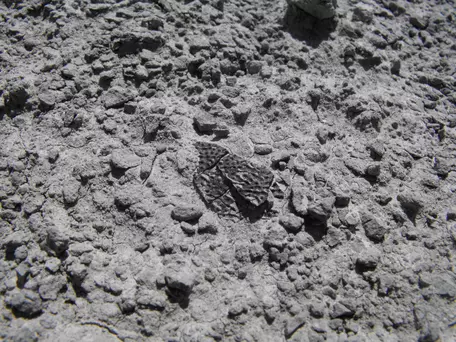


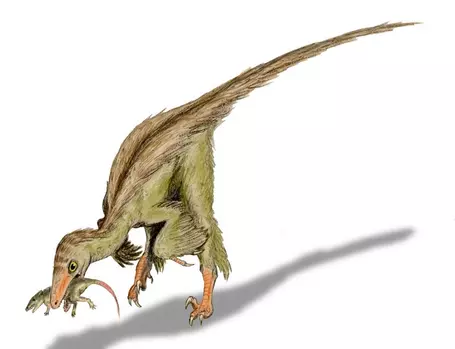

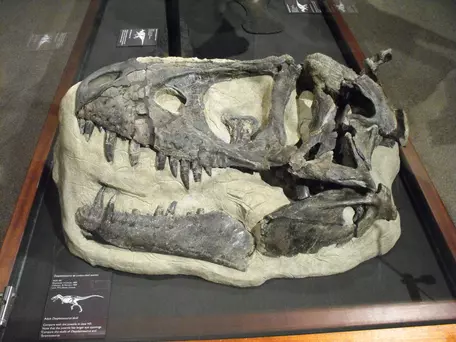

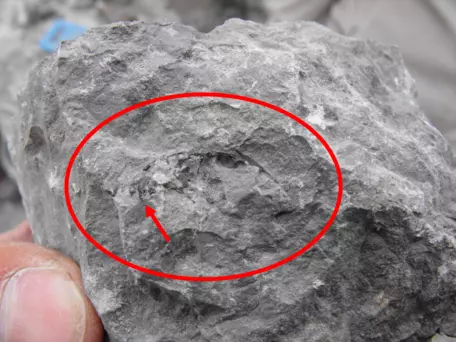

![[reuse info]](/images/information_16.png)
